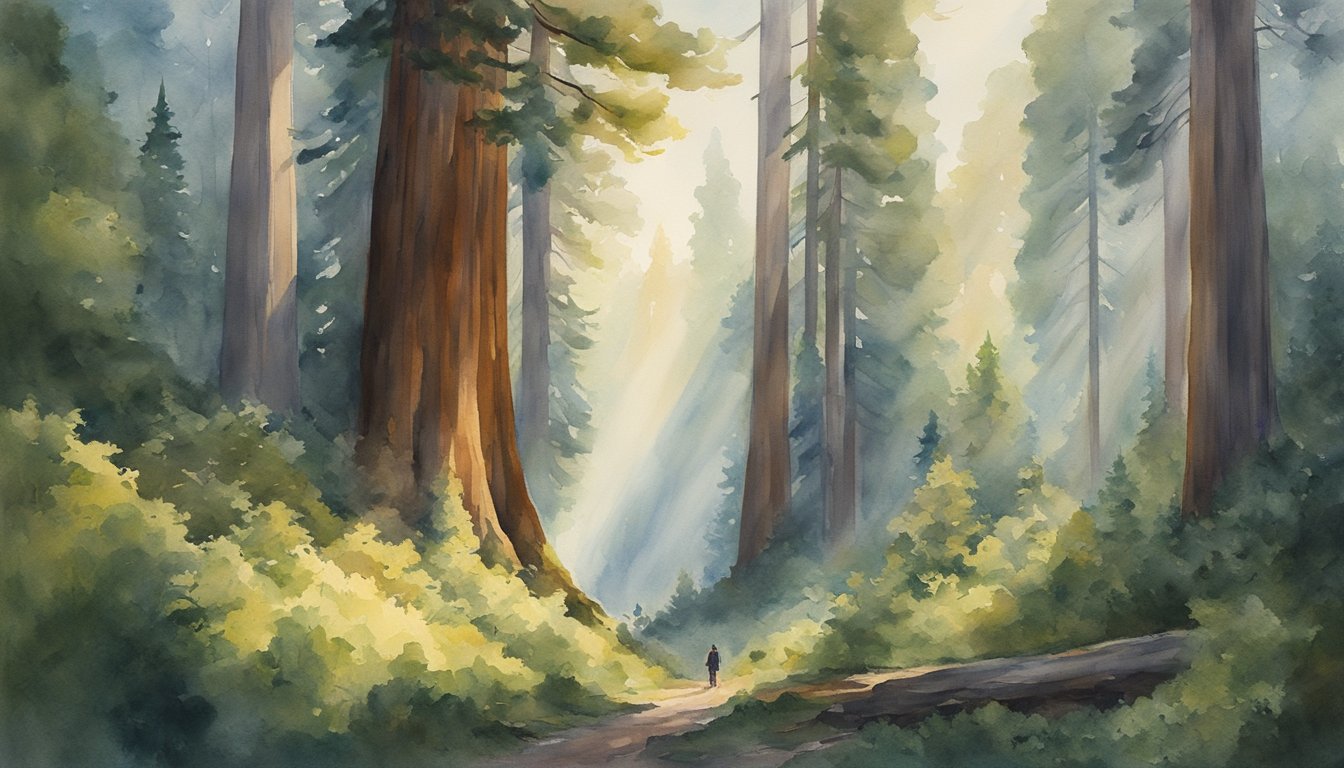Introduction to the Redwood Giants
Exploring the redwood giants is a journey into some of the most awe-inspiring natural wonders on Earth. Towering high above the forests of California, these ancient sentinels are a testament to the grandeur of nature.
What Makes a Redwood
Redwoods are known for their immense height and girth, making them one of the most magnificent tree species around. They thrive in the foggy coastal climate of California, forming part of a unique ecosystem. Belonging to the subfamily Sequoioideae, these trees are coniferous, bearing cones and evergreen needles.
Redwood Species Overview
There are three recognized species within the redwood family. Sequoia sempervirens, commonly known as the coast redwood, is celebrated for being the tallest tree species on the planet. The giant sequoia (Sequoiadendron giganteum), while not as tall, can achieve greater mass and boasts the largest single tree by volume. The Metasequoia (dawn redwood), is a smaller, water-loving species known for its unique deciduous nature.
Defining Characteristics
Redwoods distinguish themselves through several key characteristics. The coast redwood (Sequoia sempervirens) can reach heights of over 350 feet, and its close relative, the giant sequoia (Sequoiadendron giganteum), can live for more than 3000 years. Their bark can grow up to one foot thick, providing excellent insulation against fire and pests. Furthermore, these trees play a critical role in their ecosystems, supporting a wide array of wildlife and maintaining environmental balance.
The Tallest of Them All

California redwoods are not only ancient and majestic but also home to the record-breaking giants of the tree world. The coast redwood species, Sequoia sempervirens, boasts several individuals that stand as the tallest trees on Earth, reaching skyward more than 350 feet.
Hyperion: The World’s Tallest Tree
Discovered in 2006, Hyperion stands at a towering height of 379.7 feet, making it the tallest known living tree. Nestled in a remote part of Redwood National Park, California, Hyperion surpasses its fellow redwoods in a stunning display of arboreal height. The exact location is kept a secret to protect the tree from potential vandalism.
Notable Tall Redwoods
Aside from Hyperion, there are several tall redwoods that have captured the fascination of dendrologists and nature lovers alike. Helios, at 374.3 feet, was once considered the tallest until Hyperion was discovered. Nearby, Icarus and Daedalus stand tall at 371.2 and 363.4 feet respectively. These trees are part of a select group of redwoods that have achieved remarkable heights, defying the odds in a race to the sky.
The Ecology of Height
The extraordinary height of redwood trees is the result of unique ecological conditions. Redwoods draw sustenance from the frequent fog that blankets their coastal habitat, which supplements their water supply, especially during dry seasons. Additionally, factors such as rainfall, age — some living for over 2,200 years — and the absence of forest fires help explain their unparalleled growth rates. The redwoods’ trunks can exceed 20 feet in diameter, and despite their age and size, they continue to grow, albeit at a slower pace, with the collective march of time and changing climatic conditions.
Conservation Efforts and Challenges

Conservation of the California redwood is crucial due to its significance in biodiversity, climate regulation, and cultural heritage. Redwood National Park and several state parks aim to protect these majestic trees, though they face ongoing challenges due to human impact and environmental threats.
Human Impact and Protection
The California redwoods, reaching skyward in Redwood National and State Parks, are subjected to various threats, primarily from human activities. Commercial logging, which once decimated vast areas of redwood forests, has largely been restricted within protected areas such as Humboldt Redwoods State Park and Jedediah Smith Redwoods State Park. Efforts led by organizations like the Save the Redwoods League and the Sempervirens Fund play a pivotal role in acquiring and preserving land, restoring habitats, and implementing policies that safeguard these giants. They work closely with the parks to ensure the trails and visitor facilities do not disrupt the redwoods’ delicate ecosystems.
Management strategies include stringent regulations to counteract the effects of human traffic and development. Despite these protections, challenges like illegal logging and off-trail trampling, which can damage the redwoods’ spongy bark and expose them to termites, remain. The considerable content of tannin in redwood bark helps resist these pests, fortifying the trees’ natural defenses.
Scientific Research and Education
Research and education are critical components in the effort to conserve the California redwoods. Universities, particularly the University of California, are involved in studying these ecosystems, focusing on the biodiversity within them, the carbon dioxide absorption of these massive trees, and the relationship between redwood health and forest fires. Their findings inform conservation tactics and support initiatives for controlled burns and planting efforts to ensure the longevity of the forests.
But it isn’t just about keeping the trees standing; educating the public plays a significant role in conservation. Muir Woods and Prairie Creek Redwoods State Park feature visitor centers and arboretum education that illuminate the importance of redwoods in the global ecosystem. This knowledge helps instill a conservation ethic in park visitors, engaging them in the shared responsibility of protecting these ancient sentinels of the forest.

